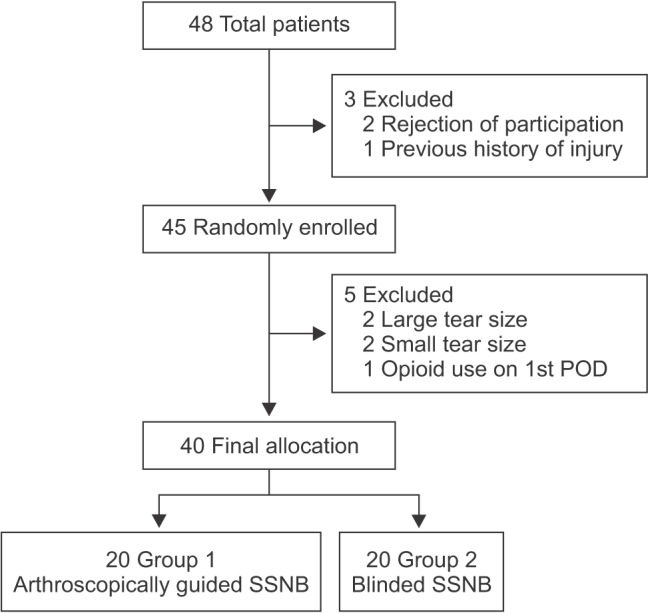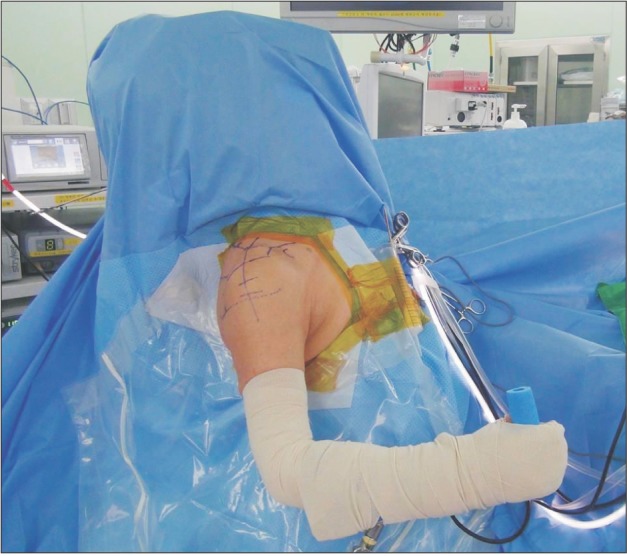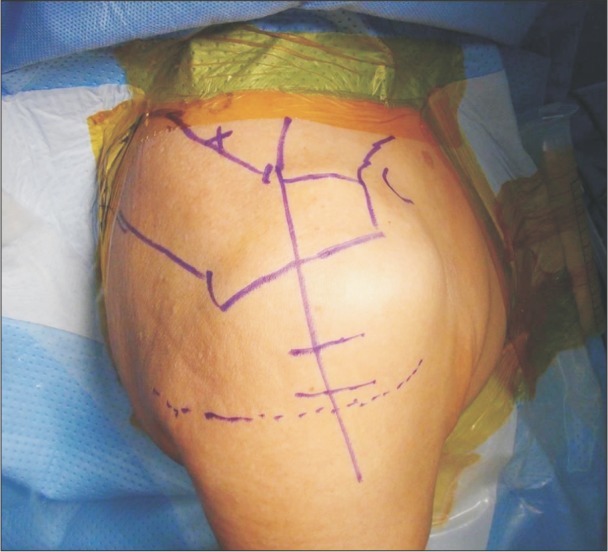Clin Orthop Surg.
2017 Sep;9(3):340-347. 10.4055/cios.2017.9.3.340.
Comparison of Arthroscopically Guided Suprascapular Nerve Block and Blinded Axillary Nerve Block vs. Blinded Suprascapular Nerve Block in Arthroscopic Rotator Cuff Repair: A Randomized Controlled Trial
- Affiliations
-
- 1Department of Orthopedics Surgery, Ulsan University Hospital, University of Ulsan College of Medicine, Ulsan, Korea. shkoshko@hanmail.net, everest@uuh.ulsan.kr
- KMID: 2412271
- DOI: http://doi.org/10.4055/cios.2017.9.3.340
Abstract
- BACKGROUND
The purpose of this study was to compare the results of arthroscopically guided suprascapular nerve block (SSNB) and blinded axillary nerve block with those of blinded SSNB in terms of postoperative pain and satisfaction within the first 48 hours after arthroscopic rotator cuff repair.
METHODS
Forty patients who underwent arthroscopic rotator cuff repair for medium-sized full thickness rotator cuff tears were included in this study. Among them, 20 patients were randomly assigned to group 1 and preemptively underwent blinded SSNB and axillary nerve block of 10 mL 0.25% ropivacaine and received arthroscopically guided SSNB with 10 mL of 0.25% ropivacaine. The other 20 patients were assigned to group 2 and received blinded SSNB with 10 mL of 0.25% ropivacaine. Visual analog scale (VAS) score for pain and patient satisfaction score were assessed 4, 8, 12, 24, 36, and 48 hours postoperatively.
RESULTS
The mean VAS score for pain was significantly lower 4, 8, 12, 24, 36, and 48 hours postoperatively in group 1 (group 1 vs. group 2; 5.2 vs. 7.4, 4.1 vs. 6.1, 3.0 vs. 5.1, 2.1 vs. 4.2, 0.9 vs. 3.9, and 1.3 vs. 3.3, respectively). The mean patient satisfaction score was significantly higher at postoperative 4, 8, 12, 24, 36, and 48 hours in group 1 (group 1 vs. group 2; 6.7 vs. 3.9, 7.4 vs. 5.1, 8.8 vs. 5.9, 9.2 vs. 6.7, 9.5 vs. 6.9, and 9.0 vs. 7.2, respectively).
CONCLUSIONS
Arthroscopically guided SSNB and blinded axillary nerve block in arthroscopic rotator cuff repair for medium-sized rotator cuff tears provided more improvement in VAS for pain and greater patient satisfaction in the first 48 postoperative hours than blinded SSNB.
MeSH Terms
Figure
Reference
-
1. Moote CA. The prevention of postoperative pain. Can J Anaesth. 1994; 41(6):527–533. PMID: 7915209.
Article2. Lee SM, Park SE, Nam YS, et al. Analgesic effectiveness of nerve block in shoulder arthroscopy: comparison between interscalene, suprascapular and axillary nerve blocks. Knee Surg Sports Traumatol Arthrosc. 2012; 20(12):2573–2578. PMID: 22434159.
Article3. Boss AP, Maurer T, Seiler S, Aeschbach A, Hintermann B, Strebel S. Continuous subacromial bupivacaine infusion for postoperative analgesia after open acromioplasty and rotator cuff repair: preliminary results. J Shoulder Elbow Surg. 2004; 13(6):630–634. PMID: 15570231.
Article4. Watcha MF, White PF. Postoperative nausea and vomiting: its etiology, treatment, and prevention. Anesthesiology. 1992; 77(1):162–184. PMID: 1609990.5. Checcucci G, Allegra A, Bigazzi P, Gianesello L, Ceruso M, Gritti G. A new technique for regional anesthesia for arthroscopic shoulder surgery based on a suprascapular nerve block and an axillary nerve block: an evaluation of the first results. Arthroscopy. 2008; 24(6):689–696. PMID: 18514113.
Article6. Kempen PM, O'Donnell J, Lawler R, Mantha V. Acute respiratory insufficiency during interscalene plexus block. Anesth Analg. 2000; 90(6):1415–1416. PMID: 10825331.
Article7. Pere P, Pitkanen M, Rosenberg PH, et al. Effect of continuous interscalene brachial plexus block on diaphragm motion and on ventilatory function. Acta Anaesthesiol Scand. 1992; 36(1):53–57. PMID: 1539480.
Article8. Nam YS, Jeong JJ, Han SH, et al. An anatomic and clinical study of the suprascapular and axillary nerve blocks for shoulder arthroscopy. J Shoulder Elbow Surg. 2011; 20(7):1061–1068. PMID: 21839653.
Article9. Brown DE, James DC, Roy S. Pain relief by suprascapular nerve block in gleno-humeral arthritis. Scand J Rheumatol. 1988; 17(5):411–415. PMID: 2463666.
Article10. Jeske HC, Kralinger F, Wambacher M, et al. A randomized study of the effectiveness of suprascapular nerve block in patient satisfaction and outcome after arthroscopic subacromial decompression. Arthroscopy. 2011; 27(10):1323–1328. PMID: 21868190.
Article11. Lee JJ, Yoo YS, Hwang JT, et al. Efficacy of direct arthroscopy-guided suprascapular nerve block after arthroscopic rotator cuff repair: a prospective randomized study. Knee Surg Sports Traumatol Arthrosc. 2015; 23(2):562–566. PMID: 23455386.
Article12. Gorthi V, Moon YL, Kang JH. The effectiveness of ultrasonography-guided suprascapular nerve block for perishoulder pain. Orthopedics. 2010; 33(4):DOI: 10.3928/01477447-20100225-11.
Article13. Harmon D, Hearty C. Ultrasound-guided suprascapular nerve block technique. Pain Physician. 2007; 10(6):743–746. PMID: 17987095.14. Wilson AT, Nicholson E, Burton L, Wild C. Analgesia for day-case shoulder surgery. Br J Anaesth. 2004; 92(3):414–415. PMID: 14742335.
Article15. Matsen FA 3rd, Papadonikolakis A. Published evidence demonstrating the causation of glenohumeral chondrolysis by postoperative infusion of local anesthetic via a pain pump. J Bone Joint Surg Am. 2013; 95(12):1126–1134. PMID: 23783210.
Article16. Chung F, Mezei G. Factors contributing to a prolonged stay after ambulatory surgery. Anesth Analg. 1999; 89(6):1352–1359. PMID: 10589607.
Article17. Schwartzberg RS, Reuss BL, Rust R. Efficacy of continuous subacromial bupivacaine infusion for pain control after arthroscopic rotator cuff repair. J Shoulder Elbow Surg. 2013; 22(10):1320–1324. PMID: 23668921.
Article18. Coghlan JA, Forbes A, McKenzie D, Bell SN, Buchbinder R. Efficacy of subacromial ropivacaine infusion for rotator cuff surgery: a randomized trial. J Bone Joint Surg Am. 2009; 91(7):1558–1567. PMID: 19571077.19. Savoie FH, Field LD, Jenkins RN, Mallon WJ, Phelps RA 2nd. The pain control infusion pump for postoperative pain control in shoulder surgery. Arthroscopy. 2000; 16(4):339–342. PMID: 10802469.
Article20. Brown SL, Morrison AE. Local anesthetic infusion pump systems adverse events reported to the Food and Drug Administration. Anesthesiology. 2004; 100(5):1305–1307. PMID: 15114230.
Article21. Busfield BT, Lee GH, Carrillo M, Ortega R, Kharrazi FD. Subacromial pain pump use with arthroscopic shoulder surgery: a short-term prospective study of complications in 583 patients. J Shoulder Elbow Surg. 2008; 17(6):860–862. PMID: 18657448.
Article22. DeMarco JR, Componovo R, Barfield WR, Liles L, Nietert P. Efficacy of augmenting a subacromial continuous-infusion pump with a preoperative interscalene block in outpatient arthroscopic shoulder surgery: a prospective, randomized, blinded, and placebo-controlled study. Arthroscopy. 2011; 27(5):603–610. PMID: 21663717.
Article23. Gollapalli L, McKelvey G, Wang H. Delayed vocal fold paralysis after continuous interscalene level brachial plexus block with catheter placement: a case report. J Clin Anesth. 2014; 26(5):407–409. PMID: 25127067.
Article24. Ko SH, Kang BS, Hwang CH. Ultrasonography- or electrophysiology-guided suprascapular nerve block in arthroscopic acromioplasty: a prospective, double-blind, parallel-group, randomized controlled study of efficacy. Arthroscopy. 2013; 29(5):794–801. PMID: 23419356.
Article25. Kang SS, Jung JW, Song CK, Yoon YJ, Shin KM. A new anterior approach for fluoroscopy-guided suprascapular nerve block: a preliminary report. Korean J Pain. 2012; 25(3):168–172. PMID: 22787547.26. Schneider-Kolsky ME, Pike J, Connell DA. CT-guided suprascapular nerve blocks: a pilot study. Skeletal Radiol. 2004; 33(5):277–282. PMID: 14872290.
Article27. Jones A, Regan M, Ledingham J, Pattrick M, Manhire A, Doherty M. Importance of placement of intra-articular steroid injections. BMJ. 1993; 307(6915):1329–1330. PMID: 8257889.
Article28. Taskaynatan MA, Ozgul A, Aydemir K, Koroglu OO, Tan AK. Accuracy of ultrasound-guided suprascapular nerve block measured with neurostimulation. Rheumatol Int. 2012; 32(7):2125–2128. PMID: 21523341.
Article29. Rothe C, Lund J, Jenstrup MT, Lundstrom LH, Lange KH. Ultrasound-guided block of the axillary nerve: a case series of potential clinical applications. Acta Anaesthesiol Scand. 2012; 56(7):926–930. PMID: 22404525.
Article30. Ritchie ED, Tong D, Chung F, Norris AM, Miniaci A, Vairavanathan SD. Suprascapular nerve block for postoperative pain relief in arthroscopic shoulder surgery: a new modality. Anesth Analg. 1997; 84(6):1306–1312. PMID: 9174311.
- Full Text Links
- Actions
-
Cited
- CITED
-
- Close
- Share
- Similar articles
-
- Regional nerve blocks for relieving postoperative pain in arthroscopic rotator cuff repair
- Comparison of Blind and Ultasonography Guided Approach of Suprascapular Nerve Block
- Postoperative pain relief effect of a suprascapular nerve block before arthroscopic shoulder surgery
- The Proximal Approach in an Ultrasound-Guided Suprascapular Nerve Block
- Partial-Thickness Rotator Cuff Tears




